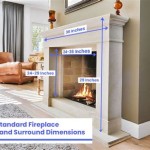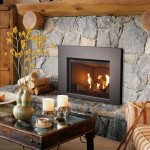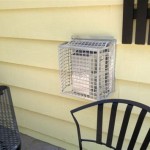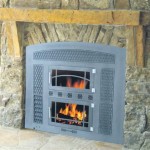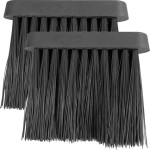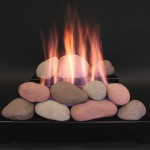Vintage Brass Fireplace Screens: A Timeless Addition to Home Décor
Vintage brass fireplace screens represent more than just functional hearth accessories; they are tangible pieces of history that bring warmth, elegance, and character to any living space. Their enduring appeal lies in the inherent beauty of brass, the craftsmanship evident in their intricate designs, and their ability to seamlessly blend practicality with aesthetic charm. These screens have been shielding homes from sparks and embers for decades, and their continued relevance speaks volumes about their enduring quality and timeless design.
The allure of vintage brass fireplace screens stems from several factors. Brass itself is a durable and visually appealing metal, known for its warm, yellow hue and its ability to develop a rich patina over time. This patina, a surface discoloration caused by oxidation, adds to the screen's vintage character, telling a silent story of years spent in use. Furthermore, the designs of these screens often reflect specific periods in history, from the ornate flourishes of the Victorian era to the geometric simplicity of the Art Deco movement. This historical context adds depth and interest, making each screen a unique conversation piece.
Considering the addition of a vintage brass fireplace screen involves understanding the various styles, materials, and maintenance requirements associated with these pieces. A knowledgeable approach ensures that the chosen screen complements the existing décor, effectively fulfills its functional purpose, and remains a cherished heirloom for years to come.
Understanding the Styles and Designs
Vintage brass fireplace screens come in a wide array of styles, each reflecting different design sensibilities and historical influences. Recognizing these styles is crucial for finding a screen that aligns with one’s personal taste and complements the overall aesthetic of the room.
Victorian-era screens are characterized by their elaborate ornamentation and intricate details. These screens often feature floral motifs, scrollwork, and depictions of animals, reflecting the Victorian fascination with nature and intricate craftsmanship. The brass is typically highly polished, lending a sense of opulence and grandeur. Such screens were designed to impress and to serve as a focal point in the room.
Art Nouveau screens, popular from the late 19th century to the early 20th century, embrace flowing lines, organic shapes, and stylized representations of nature. These screens often incorporate elements such as irises, lilies, and dragonflies, reflecting the Art Nouveau movement's emphasis on natural forms. The brass might have a slightly softer finish compared to Victorian screens, creating a more subtle and organic look.
Art Deco screens, prevalent in the 1920s and 1930s, showcase geometric patterns, streamlined shapes, and a sense of modern sophistication. These screens often feature stepped designs, zigzags, and stylized floral motifs, reflecting the Art Deco movement's emphasis on modernity and geometric abstraction. The brass is often highly polished and may be combined with other materials such as glass or chrome for added visual interest.
Mid-Century Modern screens, popular from the 1940s to the 1960s, embrace simplicity, functionality, and clean lines. These screens often feature minimalist designs, with an emphasis on geometric shapes and open spaces. The brass may have a brushed or matte finish, reflecting the Mid-Century Modern movement's emphasis on natural materials and understated elegance. Some designs incorporate teak or other woods for a warmer, more organic feel.
Beyond these broad categories, there are also many unique and eclectic designs that defy easy classification. These screens may incorporate elements from different periods or feature original and distinctive motifs. Exploring a wide range of styles is important for finding a screen that truly reflects one's individual taste and complements the specific character of the room.
Materials and Construction: Assessing Quality and Durability
The quality and durability of a vintage brass fireplace screen depend on the materials used in its construction and the craftsmanship involved in its creation. Understanding these aspects is essential for making an informed purchase and ensuring that the screen will provide years of reliable service.
The primary material is, of course, brass. The quality of the brass can vary considerably, depending on its composition and thickness. Higher-quality brass is typically more resistant to corrosion and tarnishing, and it will retain its luster for longer. Thicker brass is more durable and less likely to dent or bend. When evaluating a screen, carefully inspect the brass for signs of damage or wear. Look for any cracks, dents, or areas of significant corrosion. Also, consider the weight of the screen; a heavier screen is generally indicative of higher-quality brass.
The screen mesh, which provides the actual barrier against sparks and embers, is typically made of steel or iron. The quality of the mesh is crucial for ensuring the screen's safety and effectiveness. Look for a mesh that is tightly woven and free from any holes or tears. The mesh should also be securely attached to the brass frame. Examine the points where the mesh is joined to the frame, ensuring that the connections are strong and well-maintained.
The joints and hinges are critical components that determine the screen's stability and functionality. Examine the joints carefully, looking for any signs of weakness or instability. Make sure that the joints are securely fastened and that there is no excessive play or wobble. The hinges should operate smoothly and without any binding or squeaking. If the hinges are loose or damaged, they may need to be repaired or replaced.
The overall construction of the screen should be solid and well-executed. The individual components should be properly aligned and securely fastened. There should be no gaps or spaces between the different parts of the screen. A well-constructed screen will feel sturdy and substantial, and it will be able to withstand the rigors of daily use.
Original manufacturing marks or stamps, if present, can provide valuable information about the screen's age, origin, and maker. These marks may be located on the frame, the legs, or the back of the screen. Researching these marks can help to authenticate the screen and to learn more about its history. However, the absence of such marks does not necessarily indicate that the screen is not authentic; many vintage screens were not marked by their manufacturers.
Maintenance and Care: Preserving the Beauty and Longevity
Proper maintenance and care are essential for preserving the beauty and longevity of a vintage brass fireplace screen. By following a few simple guidelines, one can ensure that the screen remains a cherished part of the home for generations to come.
Regular cleaning is important for removing dust, dirt, and soot that can accumulate on the screen's surface. Use a soft cloth or brush to gently wipe down the screen on a regular basis. Avoid using harsh chemicals or abrasive cleaners, as these can damage the brass and the mesh. For more stubborn dirt or grime, a mild soap and water solution can be used. Be sure to thoroughly dry the screen after cleaning to prevent water spots and corrosion.
Polishing the brass can help to restore its luster and to remove any tarnish or discoloration. There are many commercially available brass polishes that can be used for this purpose. Follow the manufacturer's instructions carefully when using these polishes. Alternatively, a homemade brass polish can be made by mixing equal parts of vinegar, salt, and flour into a paste. Apply the paste to the brass, let it sit for a few minutes, and then rinse it off with water. Dry the brass thoroughly after polishing.
Protecting the screen from moisture is crucial for preventing corrosion. Avoid storing the screen in damp or humid environments. If the screen is exposed to moisture, be sure to dry it thoroughly as soon as possible. Applying a coat of wax polish can help to protect the brass from moisture and to prevent tarnishing.
Periodic inspections are important for identifying any potential problems before they become serious. Examine the screen regularly for any signs of damage, such as cracks, dents, or loose joints. If any problems are detected, address them promptly. Loose joints can be tightened with screws or glue. Cracks and dents may require professional repair.
When not in use, store the screen in a safe and dry place. Avoid storing the screen in direct sunlight, as this can cause the brass to fade and to discolor. Consider covering the screen with a cloth or plastic sheet to protect it from dust and scratches.
Repairing any damage promptly is crucial to maintain the screen’s integrity. If a screen shows signs of damage, consult a professional restorer who specializes in metalwork. Attempting complex repairs without proper knowledge can further damage the screen and diminish its value.
By following these maintenance and care guidelines, one can ensure that a vintage brass fireplace screen remains a beautiful and functional addition to the home for many years to come. These screens represent a tangible link to the past, and their preservation is a testament to their enduring value and timeless appeal.

Vintage Brass Peacock Fireplace Screen Cover Cameo Folding Fan Israel

Antiqued Brass Fireplace Screen Reviews Crate Barrel

Vintage Brass Fireplace Screen Fire Place Panel

Vintage French Country Gold Metal Brass Fireplace Screen With Curtain Chairish

Vintage Brass Peacock Fireplace Screen Cover Cameo Folding Fan Victorian Antique

Vintage Brass Fire Screen 1930 For At Pamono

Vintage Heavy Brass Fireplace Screen High Quality Long Valley Traders

Amos Brass Fireplace Screen Reviews Cb2

Arteriors Brooklyn Hollywood Regency Antique Brass Fireplace Screen Kathy Kuo Home

Vintage French Provincial Style Brass Fireplace Screen At 1stdibs Antique

